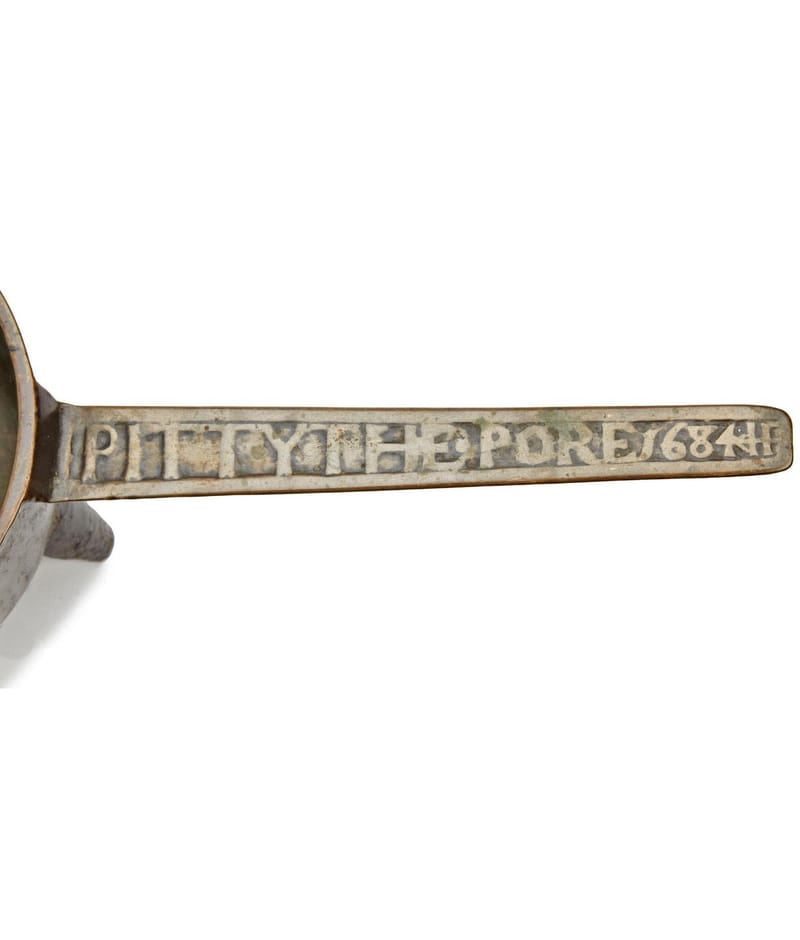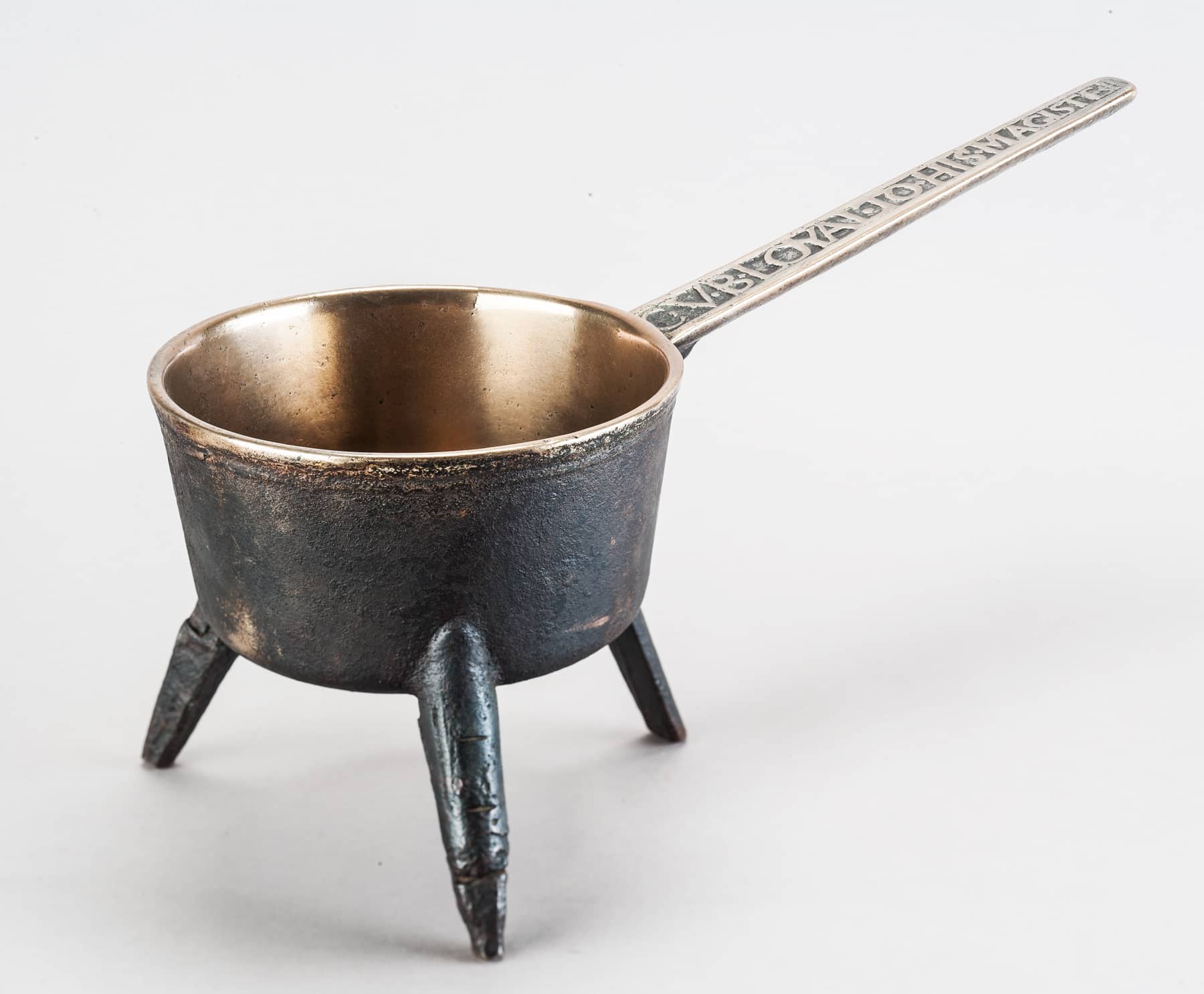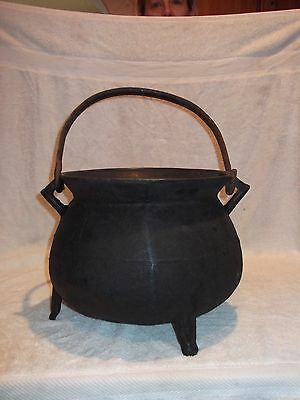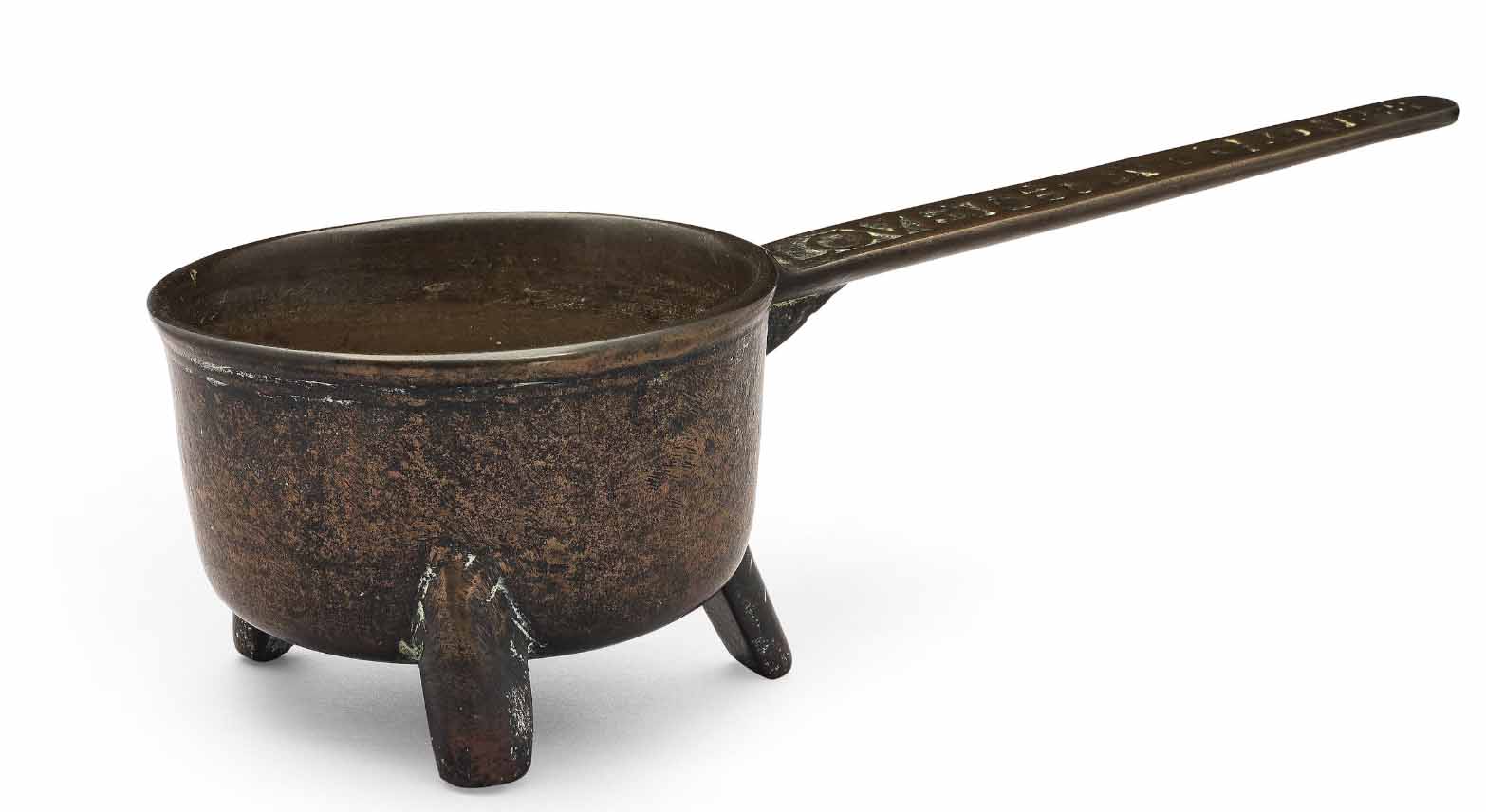Montacute Foundries bells and pots 1300-1800

Image: John Fathers "Pitty The Pore 1684 JF" engraved skillet handle from Bonhams website
For centuries food used to be cooked over open fires in large hearths in bronze cooking vessels. Bellfounders probably produced pots as their main income, and early bronze cauldrons and 'posnets' (pots with long handles) were rounded, often with 3 legs, and were cast in 'loam' moulds. These evolved into flatter-bottomed pots and skillets in the 15th and 16th centuries due to changes in hearth design and cooking techniques: by the late medieval period, hearths began to shift from deep open fires to wider fireplaces with iron firebacks and sometimes grates, allowing pots to sit on or near hot embers, not just be suspended over flames. Increasing use of iron trivets, stands, or griddles over the coals meant that flat-bottomed pans had a stable surface to rest on, unlike earlier rounded or three-legged vessels. There was also a gradual change in cooking habits, with more frying, browning, and simmering—techniques better suited to shallow, flat-bottomed pans like skillets.
By the end of the 16th century, bronze potfounding had mostly disappeared from towns and industrial regions, but it continued in rural areas of southern England, including Somerset. This was partly because cast iron cookware—cheaper and more durable—was beginning to be produced in other parts of the country, especially in the Midlands and the north, where iron resources and water-powered furnaces were more developed. By the end of the 16th century potfounding was confined mostly to rural communities in the South of England; the Sturton family of South Petherton and then the related Fathers foundry of Montacute were major producers of bronze pots serving served local markets where cooking habits and tools changed more slowly, and where smaller-scale production remained practical. Sand-casting techniques came in during the 17th century allowing addition of fine detail to the castings. (ref 'English Bronze Cooking Vessels' by R. Butler & C. Green 2006, ISBN 0861833856).
In the early 18th century cheaper cast iron pans came into production, however these Somerset foundries continued to produce high quality bronze skillets.
The photos below show a striking display of ceiling-hung cauldrons and skillets (left) and a close up of 3 skillets (right) at the Museum of Somerset in Taunton.

Mottoes
Mottoes were often incorporated into castings, giving insight into the priorities of their makers; this is seen with the typically religious themes of Wiseman's church bells, for example “Hee that heareth mee to sound let him alwaies praise the Lord 1614”, and also on skillets, where the mottoes on the handles are more suited to the hearth. Maxims appeared on Sturton's skillets from 1670, e.g. "FOR MY FRIEND", BE CONSTANT", "THIS IS GOOD WARE" and "WILL THIS PLES YOV". The Fathers foundry followed suit with e.g. "PITTY THE PORE 1684" (the worst winter of the 'Little Ice Age' of the 1600's occurred in this year), and "C V B LOYAL TO HIS MAGISTE" (see you be loyal to His Majesty), likely a reaction to Monmouth's rebellion of 1685, as well as "LOVE THY NEIGBOVR", "PRAIES GOD FOR ALL", and "Y WAGES OF SIN IS DEATH".
The three Montacute Foundries
We know of three Montacute foundries. Casting kitchen pots is likely to have been the main turnover of all of them; all are also known to have made church bells.
Thomas Hey's Foundry
The original 5 bells of Montacute's St Catherine's church were cast in the 1300s by Thomas Hey who had his foundry in Montacute at Smith’s row; these bells were bought by the parish at the time of the reformation. None of them remain in Montacute, however 6 of Hey's bells are still around; a bell at West Chinnock and one at Pitney are inscribed “Sancte Katerina de Monte Acuto” (https://stcatherinesmontacute.wordpress.com/montacutes-bells/). These bells are believed to have been made between 1350 and 1399. A 1915 SANHS publication by Melville Ross records that there is also an unusual cross character on these 2 bells and also on the bell at Nether Ham (Low Ham) that I presume is Hey's foundry mark, I am still trying to find a picture of this.
The Wiseman Foundry
After Thomas Hey came the Wiseman family who were casting bells in the village from about 1589 or earlier to at least 1641; their foundry was on the western side of Bishopston, approximately opposite the Working Men’s Club. At least 32 Wiseman bells are still in existence and 3 of these are still in Montacute and rung regularly; bell No.2 is inscribed “First I call to wake you all Anno Domini 1619 T.E.G.C.”; bell No.3 is inscribed “Geeve thankes to God Anno Domini 1610”; and bell No. 4 is inscribed “Hee that heareth mee to sound let him alwaies praise the Lord 1614”. Bell No. 5 was probably also a Wiseman bell originally, but it was recast in 1810 by Thomas Mears of London. Robert Wiseman produced bells from 1589 to 1619 (32 Bells on Dove's register), William Wiseman was active from 1619 (9 bells) and William and John Wiseman produced bells together from 1629 to 1641 (5 bells) while there are 3 bells attributed to John Wiseman alone dating from 1639 to 1641. In The Bells and Belfries of Dorset (2000), Dalton says the Church of St Laurence at Holwell near Sherborne had a 1609 bell by Robert Wiseman that was re-cast but with the original inscription copied onto it: "BEE MEKE AND LOWLY TO HEARE THE WORDE OF GOD"
In English Heritage Extensive Urban Survey: An archaeological assessment of Montacute by Miranda Richardson it says "Forty-six Wiseman bells could still be found in Somerset in 1974 (Dunning 1974:218). Aston and Leech (1977:106) have suggested the location of this industry in the town".
The Fathers foundry
The Fathers bronze foundry in Montacute produced cooking pots and bells from the 1500s to the 1700s; the foundry site in Montacute is not known. 2 bells produced by John Fathers the younger in about 1749 are still in Brecon in Wales. Examples of their products can be found online and some are shown below; see also R. Butler & C. Green, English Bronze Cooking Vessels & their Founders 1350 - 1830 (2003), pp. 49 - 64.
Below: 5 skillets for sale on the BADA.org website in 2024 (image from BADA website). The pots are
5.5 inch diameter, 13.5 inch long, motto ‘LOVE*THY*NEIGBOVR’
6 inch diameter, 14 3/8 inch long, motto. ‘PITTY*THE*PORE*1684’
6.5 inch diameter, 15.75 inch long, motto PRAIES*GOD*FOR*ALL
7 inch diameter, 16.75 inch long, motto ‘Y.*WAGES*OF*SIN*IS*DEATH
7 7/8 inch diameter,18 inch long, motto ‘C.V.B LOYAL TO HIS MAGISTE'
Below: (Image from Bonhams website) Auctioned by Bonhams in 2015, these skillets may have originally been sold as a set of 5 as above.
THREE CHARLES II LEADED BRONZE SKILLETS, BY THE FATHERS FOUNDRY OF MONTACUTE, SOMERSET
"Two from the graduated set of motto skillets, the larger cast 'PRAIES GOD FOR ALL' to the handle, the smaller 'PITTY THE PORE 1684', both with the late 17th century foundry mark of the initials 'IF' bisected by a fletched arrow, the first 16.7cm diameter; the second 15.2cm diameter, the handle of the third, large skillet cast 'IOHN FATHERS', the words spaced by three geometric shapes, 19.7cm diameter."
Below, auctioned in 2019 by Bonhams (image from their website): A LATE 17TH CENTURY LEADED BRONZE SKILLET, CIRCA 1680, BY THE FATHERS FOUNDRY OF MONTACUTE, SOMERSET
Below: Image from the BADA website: an example of a leaded bronze skillet from the Montacute, Somerset foundry of John Fathers I.

Below: 17th Century cauldron by JAMES FATHERS (1606-1669) from picclick:



